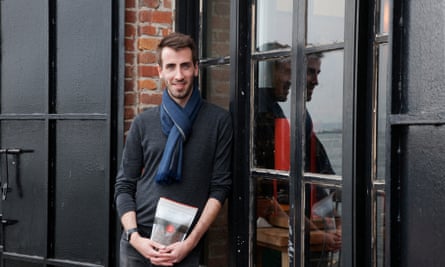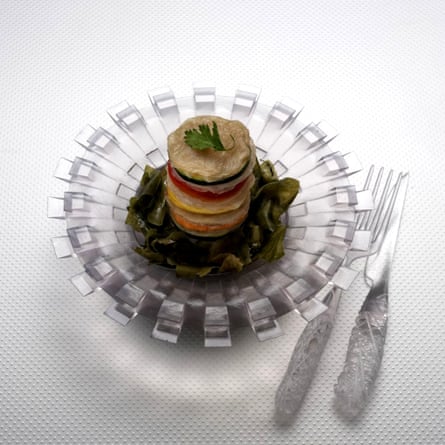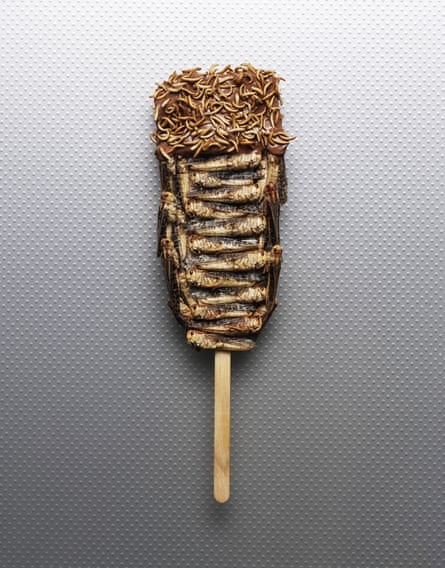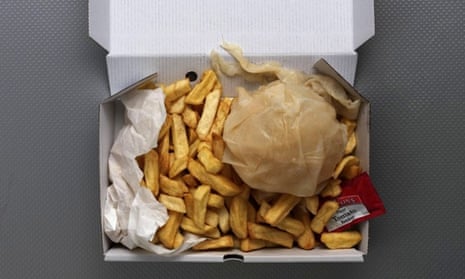In the first section of our future of food feature, we look at some of the adjusted, alternative, and entirely new foods which could become the mainstays of tomorrow’s mealtimes.
JELLYFISH
With numbers booming in UK waters, jellyfish could become an attractive addition to our cuisine – edible species are already tucked into in other parts of the world, including China. “They are an under-used resource from the sea,” says food writer and TV presenter Stefan Gates. Low in calories and with an unusual texture, they certainly add a certain something to a dish. “It sounds a bit weird, but the texture is something between cartilage and rubber,” says Gates. “They don’t have a vast amount of flavour but they are a vehicle for flavour.”
Indeed Gates believes we should abandon trepidation and embrace unusual foods. “Generally speaking we have to be more open minded about what we are eating because we tend to be mono-culinary, we always stick to the same foods all the time and it plays havoc with the world’s resources,” he says. “Also, it’s an adventure to go on.”
ND
ALGAE

Algae such as spirulina and chlorella, which are available as supplements or powders, are a favourite among health foodies and vegans, and are thought to be good sources of vitamins, protein and minerals such as iron.
But alga-based drinks may now be moving out of the obscure corners of healthfood shops and in to the mainstream. Companies like French start-up Algama want to break away from this narrow market and “feed humanity”. Their product, Springwave, which launches in France this month, uses spirulina extract in a flavoured-water drink that lacks the typical spirulina taste. Other algal offerings that may tempt shoppers include frozen spirulina by Spirulina Ice and chlorella-containing flavoured rice snacks by Allma.
RD
ALLERGY-FREE PEANUTS
If there’s one commodity the food industry could be expected to shell out for, it’s hypoallergenic peanuts. An estimated 1.4-3.0% of children in western countries are allergic to them, putting the kibosh on the consumption of a host of comestibles. But if a small startup has its way, that could all change.
University of Toronto graduates Chloe Gui and Terry Huang are hoping to create peanuts that are free from specific proteins that trigger potentially life-threatening reactions in humans.
It’s a fledgling enterprise – after creating their company, Aranex Biotech, in April, Gui and Huang moved to Ireland to take part in Indie.bio’s three-month synthetic biology accelerator programme hosted at University College, Cork. Their plan – to use a genome editing technique called Crispr-Cas9 to essentially “turn off” the genes that code for main peanut allergens. It’s a technology that grabbed the headlines this year when the Crispr-Cas9 system was used by scientists to edit the genomes of human embryos.

So far Gui and Huang have taken cells from the leaves of peanut plants, removed the cell walls using an enzyme and then inserted the Crispr-Cas9 system by chemical means. Their results, says Gui, are promising – but there is a long way to go - to create whole plant the team must use a different method of inserting Crispr-Cas9 into plant cells and are currently planning to utilise a soil bacterium. “We are at the stage where we know Crispr works in peanut plants, now we want to regenerate a full plant,” says Gui, adding that the duo are now looking to establish themselves in Norwich, a hub for plant science.
It’s not the first attempt to find a solution to the issue of peanut allergies. Scientists have explored several GM techniques, including interfering with cellular processes that generate the problem proteins, while non-GM approaches include soaking peanuts in enzymes that break down the allergens. But using Crispr-Cas9, Gui believes, could be an effective alternative. Others agree “Scientifically, yes it is feasible,” says Professor Peggy Ozias-Akins from the University of Georgia, who has conducted previous work on hypoallergenic peanuts. But, she adds, that there could be other complications. “As far as how a peanut deficient in these proteins would actually be utilised by industry is less well defined at this point.”
According to Gui, heavyweight confectioners have already pricked up their ears, keen to see the work develop. But she says there will be hurdles to overcome, not least that it is unlikely to be possible to turn off all the genes for all known peanut allergens. “You have to balance how many genes you can knock out while maintaining the viability of the plant,” she says. And even if the team manages to produce hypoallergenic peanuts, the problem of perception remains — Gui and Huang are keen to avoid the GM label, meaning they are simultaneously looking to explore a range of routes to their proof of concept plant.
It’s a project that will take time, but Gui is enthusiastic. “It’s never been a better time to do this sort of thing,” she says.
ND
LAB-GROWN MEAT
Overcome with the ills of animal production, Shir Friedman has a vision. She wants to grow chicken breasts in the lab. “It is very similar to what researchers are doing to culture organs for transplants,” says the co-founder of Israeli-based charity, Modern Agricultural Foundation. Except they would be for human consumption. In January it gave a grant to a Tel Aviv University biomedical engineer for a feasibility study of the proposition. Results expected at the end of this year will be used to plan the organisation’s next steps. If successful, it would be the most ambitious project yet on the new food frontier of cultured animal products, where animal cells will eventually be grown in vats to make meat. “Production will look like a brewery,” says Sarah Sclarsic, business director at Modern Meadow, a US startup working to make meat products from cultured cow muscle cells.

But getting costs down to a level competitive with the animal version is daunting. Mark Post, a researcher at Maastricht University in the Netherlands, unveiled the world’s first cultured beef burger made from cow stem cells in 2013. It cost £200,000 to make, but even if it were scaled up it would still be £15 per kilo for hamburger meat. There may also be regulatory hurdles. “We are hoping the process would be fairly straightforward but that remains to seen,” says Sclarsic.
Meanwhile, technology is also rising to the challenge of producing realistic meat analogues from plants. San Francisco bay area startup Impossible Foods says it has a new way to create a meat taste from plant proteins by concentrating a heme protein – which gives red meat its colour – that is naturally found in plants in small quantities. It plans to tempt meat lovers with its plant-based hamburger patties in the second half of next year. The product “looks, cooks, smells and tastes like ground beef”, says Patrick Brown, company co-founder and a professor of biochemistry at Stanford University. Competition in the meat stakes, it seems, is coming from everywhere.
ZC
VEGAN CHEESE
“Kind of like mozzarella,” is how Patrik D’haeseleer describes his latest prototype. D’haeseleer is a key figure in the Real Vegan Cheese project, established in early 2014 with the aim of making cheese without cows. The project is a crowd-funded, not-for-profit, volunteer effort run out of two biohacking spaces in the San Francisco Bay area.

Real Vegan Cheese isn’t the only one with big ambitions. Startups Muufri and Clara Foods, also both in the Bay area, are aiming to make milk and egg whites respectively without the use of animals. The technology behind all of them relies on genetically modifying cells of baker’s yeast to become microscopic factories that produce milk – or egg – protein. Those proteins, called caseins and albumins respectively, give milk and egg whites many of their physical properties.
It is unclear, however, exactly when these new synthetic dairy products might debut. Speaking at an event on the future of food the end of May in San Francisco, Muufri co-founder Ryan Pandya said he was hoping to have a proof-of-concept product ready by the end of this year or early next, but don’t expect to see it at a grocery store any time soon.
“According to our preliminary estimates this is going to be a several hundred dollar glass of milk,” he said. Clara Foods co-founder Arturo Elizondo added his company was aiming to have batches of egg whites ready by early next year for corporate partners to test.
At the Real Vegan Cheese project, the milk- and cheese-like prototypes made so far have been tests of what can be done with caseins, fat and sugar, but they use animal-derived casein powder. Genetically engineering yeast to spit out caseins synthetically has proved difficult.
“It should definitely be do-able,” says Benjamin Rupert, another of the project’s leaders. “The yeast cell is complicated and people usually have to try a few times.”
Technical challenges aside, the products – despite the environmental benefits of less animal farming – are already raising the hackles of environmental groups.
“Nobody I know wants to eat synthetically produced dairy made from genetically modified yeast in a lab,” says Dana Perls, a food and technology policy campaigner at Friends of the Earth. Both Muufri and Clara Foods still seem to be deciding how to frame where their products come from, and to what extent they will revel in them being derived from genetically modified organisms.
“If it means coming up with a new sort of language to speak to the public then we have to do that,” said Pandya.
ZC
FERMENTED COFFEE
Camille Delebecque is founder and CEO of Afineur, a Franco-American startup, who raised more than $50,000 on Kickstarter to produce a coffee with a unique flavour created through controlled fermentation.

Coffee’s already quite popular – how are you improving it?
We’re not rewriting coffee, we’re shining a new light on it. People are starting to look for coffee that’s not just bringing the morning buzz, but interesting in terms of flavour. At the moment, the coffee industry only has two tools to control the flavour: choosing the beans, and roasting. So fermentation is a really powerful third tool.
How does it work?
We do our fermentations directly on the processed green beans. We slightly humidify them, and sprinkle them with the bacterial strain, either as a fluid or a powder. After fermentation we do a roasting right away, which sterilises everything and removes the microbes, but the chemical changes remain.
How do the bacteria affect the flavour?
It’s not the bacteria themselves that confer the flavour; the bacteria produce enzymes that induce specific chemical reactions within the beans. We’re focusing on lowering bitterness and astringency, and we know specifically which molecules are responsible for which flavours. Trigonelline, for instance, causes bitterness.
But isn’t coffee supposed to be bitter?
If you look at market surveys, bitterness is the number one taste that people dislike the most in coffee. Also, bitterness tends to overpower the more subtle flavours, so by removing it you allow the more floral and fruity notes to shine.
Did you get the idea from kopi luwak (the expensive and controversial Indonesian coffee made from cherries which have passed through the bowels of a civet)?
Kopi luwak made me realise the potential of fermentation in coffee, but I thought there must be a better way to do it. We use a very controlled process, and we’re not just reducing bitterness, we’re bringing out new flavours, and removing some of the irritant chemicals as well. Caffeine, actually, is one of the irritants – we’re lowering the caffeine by about 15%.
What’s next?
With increased understanding of biology we can do things with microbes that we couldn’t before, so we’re looking at foods beyond just coffee. Fermentation could replace a lot of the artificial flavouring, a lot of the chemicals that have been used in the food industry for the last 40 years, and we can do it naturally and in a better way.
Interview by KB
TWO FUTURISTIC RECIPES
Food writer, presenter and ‘gastronaut’ Stefan Gates has designed two exclusive recipes for the Observer, based around new ingredients. Bon appétit!
Jellyfish salad timbale

Take a packet of salted jellyfish and soak in water for 3-4 hours to remove the salt. Then make a marinade/dressing from sesame oil, fish sauce, chilli, soy sauce, fresh lime juice and caster sugar. Cut the jellyfish into the shape of your timbale ring (a small cup will do just fine), and soak in the dressing while you prepare an assortment of sweet and savoury layers. Use your timbale ring/cup to make slices of roasted red peppers, mango slices, avocado slices, courgettes, roasted sweet potato and pineapple. Arrange them all into little towers, alternating between the different ingredients. Top with a sprig of coriander. Serve on bespoke 3D-printed tableware, such as this futuristic bowl and cutlery by Hobs Studio.
Cricket noodle stir-fry
High in protein, low in carbon emissions, insects are not only nutritious but get an environmental thumbs up, too. “It’s like the perfect storm of food in terms of ethical and health reasons,” says Stefan Gates, who believes insects will be mainstream rather than a novelty. “Freeze-dried ones, the ones we get in the UK, are not the culinary peak of the insect kingdom - they are a good fun, gimmicky start” he says, “we won’t be eating them like the lollipop [below], but there will be burgers.”

Make a sauce from grated ginger, chilli, soy sauce, sesame oil, garlic, lime juice and hoisin sauce. Cook noodles, drain, rinse and set aside. Stir-fry a large handful of crickets in hot oil until they brown. Set aside while you stir-fry chopped red peppers, courgettes, carrots, cashews and green beans. Add the noodles, sauce and crickets and toss to mix. Serve with coriander.
SG

Comments (…)
Sign in or create your Guardian account to join the discussion